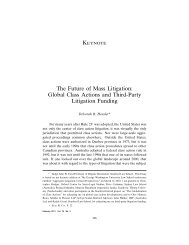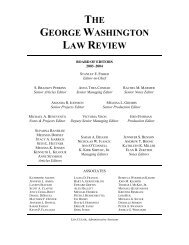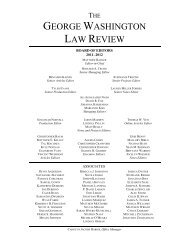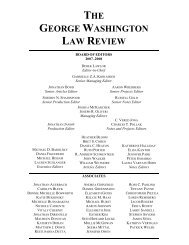View PDF - The George Washington Law Review
View PDF - The George Washington Law Review
View PDF - The George Washington Law Review
You also want an ePaper? Increase the reach of your titles
YUMPU automatically turns print PDFs into web optimized ePapers that Google loves.
900 <strong>The</strong> <strong>George</strong> <strong>Washington</strong> <strong>Law</strong> <strong>Review</strong> [Vol. 78:870<br />
erning takings doctrine and the benefits that an inheritance exception<br />
to the proposed doctrine will provide.<br />
B. What About the Distinct Investment-Backed-Expectations<br />
Factor?<br />
Along with economic impact and character, the Court also enumerated<br />
a third factor, distinct investment-backed expectations, in<br />
Penn Central. Critics would be correct to point out that the distinct<br />
investment-backed expectations factor deserves a home in regulatory<br />
takings jurisprudence. What that criticism fails to recognize is that the<br />
per se rule based on cost-basis economic rationale accounts for such<br />
expectations. <strong>The</strong>refore, this distinct investment-backed expectations<br />
factor has a home in the proposed regulatory takings doctrine.<br />
When analyzing distinct investment-backed expectations, courts<br />
determine whether the purchaser of the property had notice of a regulatory<br />
constraint already in place. 146 Courts viewed notice, prior to<br />
Palazzolo v. Rhode Island, as either barring or, at the very least,<br />
weighing heavily against takings claims. 147 Although Justice Kennedy’s<br />
opinion in Palazzolo rejected the notion that notice should be<br />
determinative, 148 it is Justice O’Connor’s concurring opinion that has<br />
gained adherence. Justice O’Connor wrote that, although notice of a<br />
regulatory constraint should not be dispositive, such notice must be<br />
weighed along with the other Penn Central factors (i.e., economic impact<br />
and character). 149 Justice O’Connor explained the importance of<br />
this factor by stating that, if notice of a regulatory constraint is not<br />
considered, “some property owners may reap windfalls and an important<br />
indicium of fairness is lost.” 150<br />
As mentioned, under a Penn Central analysis, the economic impact<br />
of a regulation is measured by a comparison of the fair market<br />
value of the property in the absence of the regulation and the fair<br />
market value of the property with the regulation. 151 Under such a system,<br />
if it were not for the consideration of distinct investment-backed<br />
expectations, an owner would have an incentive to purchase a heavily<br />
regulated property at a low price and then bring a Fifth Amendment<br />
takings suit to recover just compensation.<br />
146 See Palazzolo v. Rhode Island, 533 U.S. 606, 626 (2001).<br />
147 See, e.g., Loveladies Harbor, Inc. v. United States, 28 F.3d 1171, 1177 (Fed. Cir. 1994).<br />
148 See Palazzolo, 533 U.S. at 630.<br />
149 See id. at 632–36 (O’Connor, J., concurring).<br />
150 Id. at 635.<br />
151 See supra note 118 and accompanying text.









